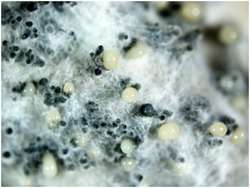Phomopsis longicolla
| Phomopsis longicolla | |
|---|---|
 | |
| Phomopsis longicolla pycnidia on soybean seed | |
| Scientific classification | |
| Kingdom: | Fungi |
| Phylum: | Ascomycota |
| Class: | Sordariomycetes |
| Subclass: | Sordariomycetidae |
| Order: | Diaporthales |
| Family: | Diaporthaceae |
| Genus: | Phomopsis |
| Species: | Phomopsis longicolla Thomas W. Hobbs, 1985[1] |
Phomopsis longicolla is a species of ascomycota fungi in the Diaporthaceae family. It is a plant pathogen and mainly responsible for a soybean disease called Phomopsis seed decay (PSD). In other plant species, P. longicolla can also live as an endophyte, such as in the mangrove plant Sonneratia caseolaris. P. longicolla has also been found to produce a number of cytotoxic and antimicrobial secondary metabolites, such as dicerandrols and phomoxanthones.[2][3] P. longicolla was first described in 1985 by Thomas W. Hobbs et al. at the Department of Plant Pathology at Ohio State University[1]
References
- 1 2 "A New Phomopsis Species from Soybean". 77: 535–544. JSTOR 3793352.
- ↑ Isaka, M; Jaturapat, A; Rukseree, K; Danwisetkanjana, K; Tanticharoen, M; Thebtaranonth, Y (2001). "Phomoxanthones A and B, novel xanthone dimers from the endophytic fungus Phomopsis species". Journal of Natural Products. 64 (8): 1015–8. doi:10.1021/np010006h. PMID 11520217.
- ↑ Lim, C; Kim, J; Choi, JN; Ponnusamy, K; Jeon, Y; Kim, SU; Kim, JG; Lee, C (2010). "Identification, fermentation, and bioactivity against Xanthomonas oryzae of antimicrobial metabolites isolated from Phomopsis longicolla S1B4". Journal of microbiology and biotechnology. 20 (3): 494–500. PMID 20372017.
This article is issued from Wikipedia - version of the 9/7/2015. The text is available under the Creative Commons Attribution/Share Alike but additional terms may apply for the media files.